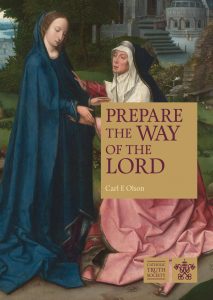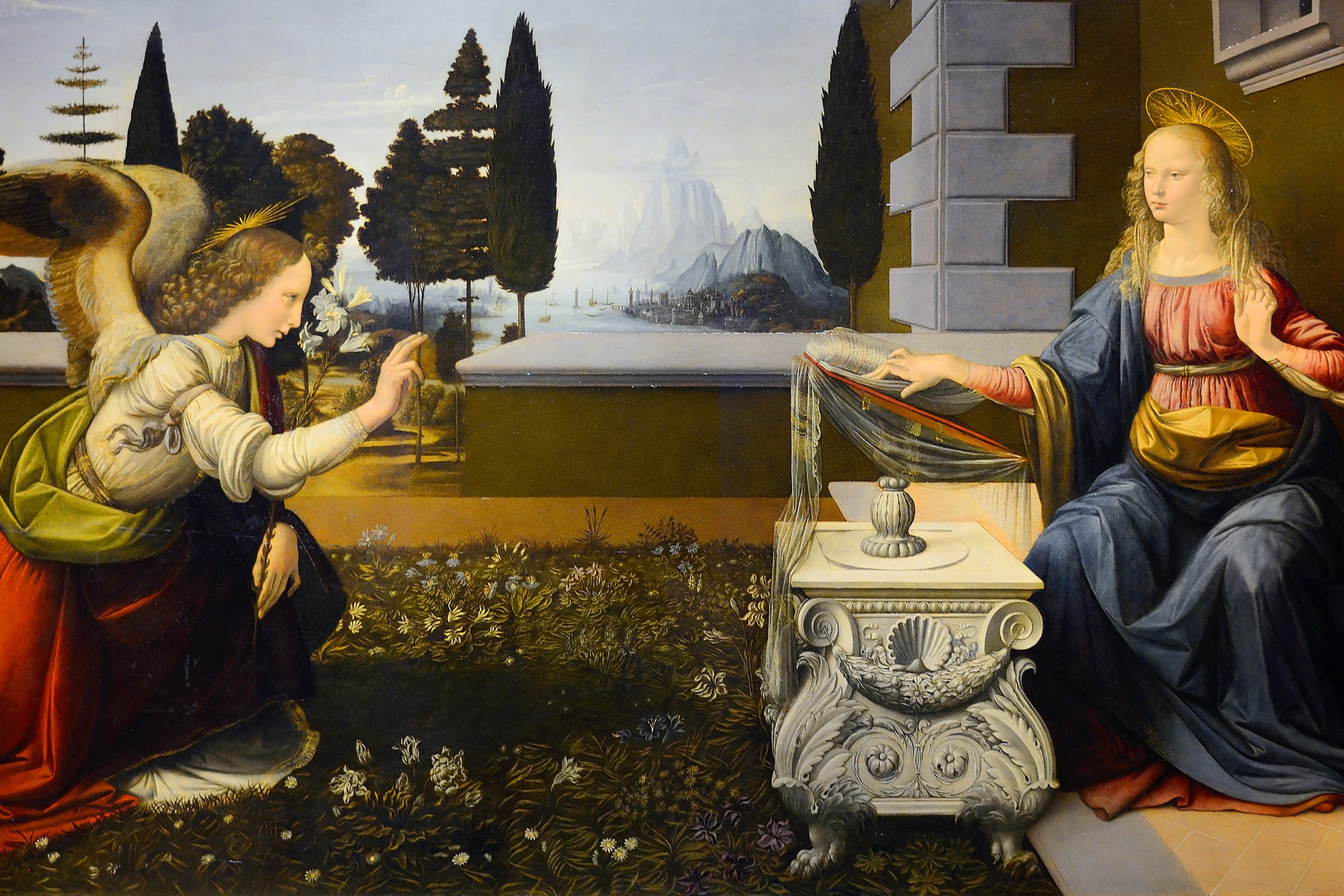“Hail Mary, full of grace, the Lord is with thee…”
An advent is a coming; it literally means “to come to”. The season of Advent anticipates the coming – or comings – of the Son: in his Incarnation two thousand years ago, in his future return in glory, and in the mystery of the sacraments, especially the Holy Eucharist. The Catechism of the Catholic Church states:
When the Church celebrates the liturgy of Advent each year, she makes present this ancient expectancy of the Messiah, for by sharing in the long preparation for the Saviour’s first coming, the faithful renew their ardent desire for his second coming. (CCC 524)
So Advent is ultimately concerned with the Son’s coming in glory, when he shall “judge the living and the dead”.
The Coming of Mary’s Son and Saviour
This might sound a bit unusual. After all, isn’t Advent about preparing for Christmas? And isn’t Christmas about celebrating the birth of the baby Jesus? It is, of course, but there are other questions to ask: Why was that baby born in a manger twenty centuries ago? Why is he coming again – as a grown and glorified King – and what does this mean for us? Are we more comfortable with a babe in a manger than with a conquering King? What is our place in all of these events?
Pondering our place in salvation history brings us to the feet of Mary, the Mother of the Saviour. Introducing Redemptoris Mater, Pope John Paul II writes:
The Mother of the Redeemer has a precise place in the plan of salvation, for “when the time had fully come, God sent forth his Son, born of woman, born under the law, to redeem those who were under the law, so that we might receive adoption as sons. And because you are sons, God has sent the Spirit of his Son into our hearts, crying, ‘Abba! Father!’” (Ga 4:4-6)
Here, in a nutshell, is the essence of Advent. God initiates; Mary responds. God offers; mankind receives. This is the way of love and faith.
As the sinless, holy Mother of God, Mary is a unique creature. But her perfection and holiness do not make her aloof or inaccessible. Instead, the Mother of the Saviour is a mother for everyone. She draws us near, desiring to reveal the fullness of her Son to the Church and to the entire world. It is fitting, then, that these reflections on the four weeks of Advent will draw upon the “Hail Mary” (dividing it into four parts) in contemplating the past, present and future advents of the Lord Jesus Christ.
Mary is the perfect example of one who is prepared for the coming of God. Young, poor and unassuming, she would become, by her free choice, the Mother of God. Faithful to God’s promise, she embraced the first advent of her Son before it occurred. John Paul II describes Mary as:
the one who in the “night” of the Advent expectation began to shine like a true “Morning Star”… For just as this star, together with the “dawn”, precedes the rising of the sun, so Mary from the time of her Immaculate Conception preceded the coming of the Saviour, the rising of the “Sun of Justice” in the history of the human race.
(Redemptoris Mater, 3)
Graceful Greeting for Grace-filled Lady
The simple words of the “Hail Mary” form a profound commentary on the coming of salvation, judgement, death, and eternal life. Formed from phrases found in Luke’s Gospel and the ancient Tradition of the Church, the “Hail Mary” is like a snapshot taken of the Virgin from the perspective of heaven, then offered to those willing to consider the depths of its beauty and truth.
It begins with the words spoken at the Annunciation. The angel declared, “Hail, full of grace! The Lord is with you!” (Lk 1:28). In Redemptoris Mater, John Paul II begins his reflections on this marvellous remark by emphasising that the plan of salvation, which is a plan of grace beyond words, means God sent forth his Son, “born of woman…so that we might receive adoption as sons”. This announcement by the angel introduces Mary into the mystery of Christ. She is blessed by God “in a special and exceptional degree”, a reality recognised by her cousin Elizabeth, who calls her “blessed…among women” (Lk 1:42).
As the Catechism notes, “Full of grace, Mary is wholly given over to him who has come to dwell in her and whom she is about to give to the world” (CCC 2676). Mary’s “Yes” to God articulates the complete gift of herself to the God of Israel. “The grace with which she is filled”, John Paul observes, “is the presence of him who is the source of all grace.” And Christmas is about the gift of that source, the greatest gift ever given. It is salvation in Christ through sharing in supernatural, Trinitarian life.
Put another way, it means coming into intimate, life-transforming communion with God, the Source of all that is good, true and holy. It’s the same communion received in the Blessed Sacrament. It’s the same Lord who will come in glory to judge the living and the dead.
The Coming (Again) of the Incarnate One
The Annunciation – the announcement of grace and favour on the young maiden Mary – marks the first time that the reality of the Incarnation was made known. Mary is “full of grace”, the Holy Father writes, “because it is precisely in her that the Incarnation of the Word, the hypostatic union of the Son of God with human nature, is accomplished and fulfilled.” (Redemptoris Mater, 9) Because Mary gave herself to God, God gives himself to mankind. The Son of God became the Son of Man so that by grace we might become what he alone is by nature: a true son.
Imagine the awe and wonder that Mary felt as the angel addressed her as “full of grace”. Advent is a time to contemplate and experience the same awesome, wondrous power in the coming of our Lord. It is a call to awaken, to look up, and to rejoice. In the words of St Paul: “the hour has come for you to awake from sleep. For salvation is nearer to us than when we first believed. The night is far gone; the day is at hand” (Rm 13:11-12a).
Towards the Fulfilment of the Kingdom
Advent is a season of hope and preparation. For what? For the return of the Christ-child as Christ the triumphant King. Which is why the Gospel reading on the First Sunday of Advent is taken from the Olivet Discourse. In it Jesus talks about another advent, his coming in glory:
Therefore, stay awake, for you do not know on what day your Lord is coming. But know this: if the master of the house had known in what part of the night the thief was coming, he would have stayed awake and would not have let his house be broken into. Therefore, you also must be ready, for the Son of Man is coming at an hour you do not expect. (Mt 24:42-44)
During Advent there is a continual connection made between the first coming of the Son and his second coming. Yet the term “second coming” can be misleading, since the Son’s return is really a completion and fulfilment of his birth two thousand years ago, not some unrelated and disconnected event. In his Advent reflection in 2001, John Paul II highlighted the continuity between the two comings, writing: “Christ is the Alpha and the Omega, the beginning and the end. Thanks to him, the history of humanity proceeds as a pilgrimage towards the fulfilment of the Kingdom which he inaugurated with his Incarnation and victory over sin and death.” For this reason, he explained, “Advent is synonymous with hope: not the vain waiting for a faceless god, but concrete and certain trust in the return of him who has already visited us.”
Catholics are sometimes reluctant to talk about the return of Christ. Perhaps they think the topic is the property of certain Evangelical Protestants whose focus on the “rapture” and Christ’s return can seem obsessive and imbalanced. Advent provides the right balance by rooting the return of our Lord in the Incarnation. “At his first coming he was wrapped in swaddling clothes in a manger,” wrote St Cyril of Jerusalem in the fourth century, adding that “at his second coming he will be robed in vestments of heavenly light”. May hope, preparation, joy and light fill our hearts during Advent.
 This blog is extracted from our book Prepare the Way of the Lord. Prayerfully discover the meaning of Christmas with this collection of meditations on the Scripture of the Advent season and line-by-line contemplations on the Hail Mary.
This blog is extracted from our book Prepare the Way of the Lord. Prayerfully discover the meaning of Christmas with this collection of meditations on the Scripture of the Advent season and line-by-line contemplations on the Hail Mary.
For more on Advent and the Hail Mary, order your copy of Prepare the Way of the Lord today.
